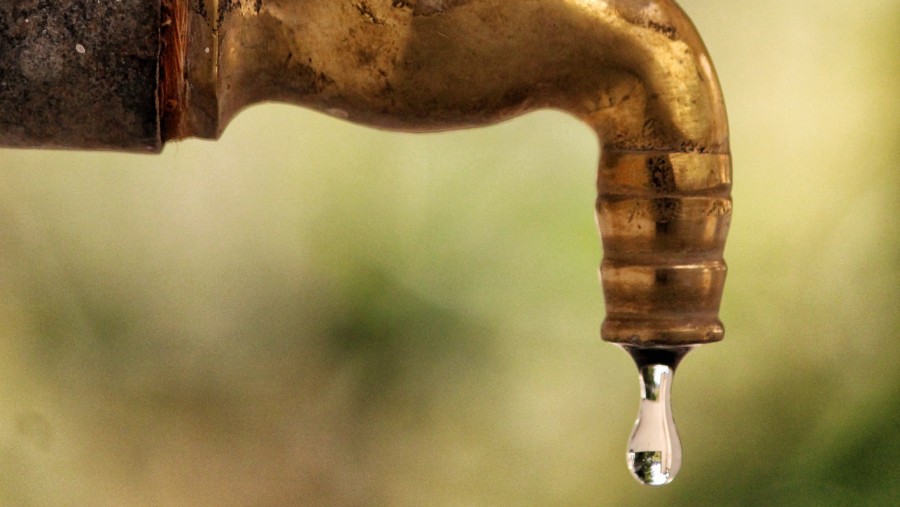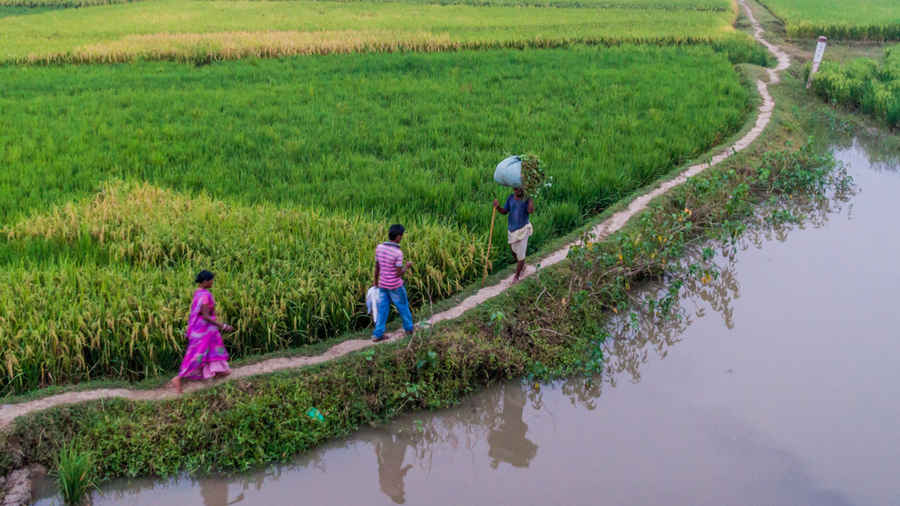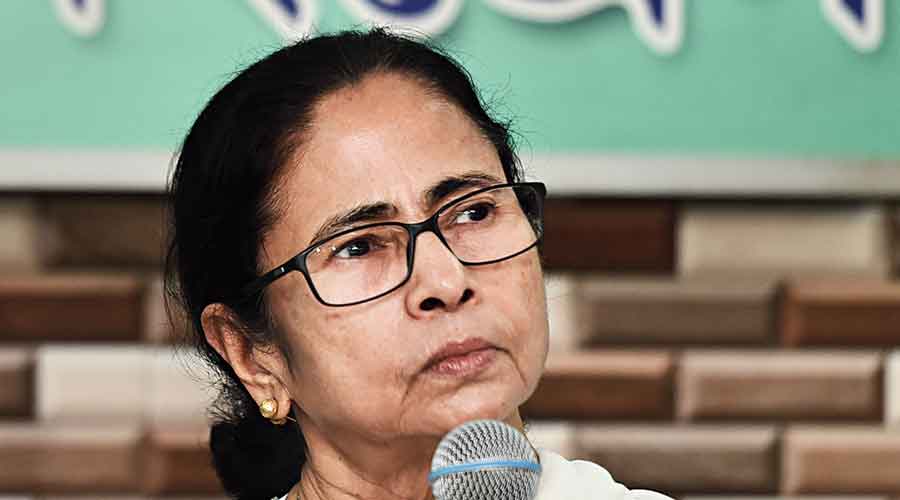Nothing can be more shameful if a government that has been in power for 18 years cannot even provide basics like clean drinking water.” So said Union home minister Amit Shah in 2018, when he was in Odisha in the run-up to the Assembly elections. A year later, after the Lok Sabha win, Prime Minister Narendra Modi promised safe and adequate water to all households of rural India by 2024, courtesy the Jal Jeevan Mission. This, after he acknowledged on the occasion of India’s 71st Independence Day that half the country’s households did not have access to piped water.
In West Bengal, after some tarrying, the Mamata Banerjee government finally agreed to embrace the central scheme. Water is a state subject but the Union government influences its supply — there are three Union ministries in charge of water. For the success of the Jal Jeevan Mission too, the Centre and the states have to work in tandem.
The Jal Jeevan Mission is about supplying potable water to rural areas. Anurag Gupta, who is regional manager, east, of the NGO WaterAid India, says this is because the coverage of piped water supply in rural India is only 18 per cent as compared to 80 per cent in the urban areas. But Bengal’s potable water issue is much more complex.
Of course, there is the accessibility issue as Aparna Mondal will testify. Aparna lives in Satjelia Island in the Sunderbans with her husband, two sons and father-in-law. She wakes up at 5 every morning and walks to the nearest tubewell two kilometres away. She carries back 10 litres of water in a large clay pitcher. She makes a second trip soon after. “I use the water for cooking and drinking. There is a greater requirement (for water) in the first half of the day than in the second half.” She makes another trip in the evening. Her husband, Dipak, says, “My mother and even my grandmother would do the same.”
Seema Murmu lives on the other side of Satjelia, where the drinking water story is the same: there is no ready availability. There is a rivulet — Datta — that slices the island. Seema takes a kheya, or country boat, once every four days to fetch water from the tubewell that Aparna also accesses. After the boat ride, Seema walks down another five kilometres. “We carry back 8-10 jerrycans of water (about 200 litres) and that lasts us four days. It is just enough for a family of four,” she tells The Telegraph.
It is Dipak who explains that these women have to brave long distances to fetch water because in these parts the water is brackish and unfit for drinking. He says, “The tubewell we use is very deep. It possibly goes down 1,500 feet, which is way below sea level.”
Brackish water, dying rivers — the potable water problems in almost all of coastal Bengal are of the same nature. Debasis Shyamal, a 40-something resident of East Midnapore, another coastal district, says, “When I was a child, we got our drinking water from a pond. Till 2010, that was how it was and then came the tubewells.”
Jharna Acharya is a resident of Jhargram district that was formed in 2017, after the bifurcation of West Midnapore. Until about 30 years ago, people here depended on pat kuas or deep wells. Says Jharna, “Only one out of six tubewells in Nayagram block had water fit for drinking. The Trinamul has provided the option of submersible pumps under the Sajaldhara scheme but that is not for everyone.” CPI(M) leader Goutam Deb points out that the scheme was first launched in 2002 at the time of the Left Front government when he was minister of the public health engineering department, but that’s another story.

CPI(M) party headquarters is rumoured to have a chronic water problem File picture
The thing to note is that offering a solution in the form of submersible pumps did not end the water problem. Why? Because it was and remains a paid scheme. Says Jharna, “In my locality, the government has fitted a pump in a local school. People who use it share the electricity bill. But there are Lodhas and Sabars here [local tribal communities] who cannot afford to pay anything.”
The Sunderbans clutch at the rear end of the Bengal map like a many-fingered hand. To its left are Jhargram, East Midnapore, and to its right is South 24-Parganas.
In South 24-Parganas, the water is high in arsenic and chlorine content. It has been this way since the mid-1980s, confirms Satyadeb Bhattacharya, who is the retired chief engineer of the state public health engineering department. It is the same with North 24-Parganas, Howrah, Hooghly, Burdwan, Nadia, Malda and Murshidabad.
Pronoy Roy, a schoolteacher from Champahati in South 24-Parganas, narrates how in his house the borewell had to be shifted four times in two years to find a spot that was arsenic-free.
The Jal Jeevan Mission addresses only rural areas, but the capital city of Bengal too faces a drinking water problem. One would find that difficult to believe of a city that got its first drinking water pipelines in 1864, but there it is. In Santoshpur in south Calcutta, there are vendors who fill carboys, or blue plastic jars, with water from corporation water taps and sell them door-to-door. Swapna Das, who stays on the fourth floor of an apartment building in Santoshpur, has to buy drinking water. She says, “The water supplied by the [Kolkata Municipal] corporation is not sufficient for all 12 flat owners and their families.” Chaitali Halder, who lives in a rented place in Ajaynagar, also in south Calcutta, has to buy jars of water in the summer months. There are households in Bhowanipore — Girish Mukherjee Road, Gangaprasad Mukherjee Road, Townsend Road — that have to depend on bhistis, or water carriers, for drinking water in the absence of piped water supply. Move from south to central to north and you will see that this is true of many households on A.J.C. Bose Road, Doctors Lane, Wellesley Square, Rafi Ahmed Kidwai Road, Entally, Alimuddin Street — even the CPI(M) party headquarters is rumoured to have a chronic water problem — College Street, Muktaram Babu Street and Sukia Street.
According to Amal Nayek, who has an NGO that works towards providing safe drinking water, “Local distributors collect water from the tubewell, filter it and sell it as mineral water.” The cheapest unbranded variety sells at Rs 30 or Rs 40 per 20-litre pack. No one is willing to come on record about the quality, but going by the sheer numbers the demand is huge. As of today, there are 350 certified packaged drinking water plants in Bengal. Even three years ago it was only 200, according to a source in the Bureau of Indian Standards, the body that provides certification to the companies.
Many-headed and overwhelming it might be, but Bengal cannot be blamed for lack of enterprise in addressing its water issue. The Tala Tank was built in the 1900s by the British and it was only then that “natives” got a regular supply of piped drinking water. In the subsequent years, many treatment plants and pumping stations were built. Arsenic treatment plants came up in the mid-1980s. The CPI(M) leader and former mayor of Calcutta, Bikash Ranjan Bhattacharya, says, “The treatment plants came into existence largely during the Left rule but the booster pumping station that is required to pump out the water from the reservoirs with some pressure happened much later.”
According to Satyadev Bhattacharya, even before he joined the public health engineering department in 1981, the drinking water system was being addressed under the Rajiv Gandhi National Drinking Water Programme. The state had one called the Minimum Needs Programme. From 1990 onwards surface-based water supply schemes were floated. Two big projects came up — one in Malda, another one in the South 24-Parganas. Later more projects have come up under the current government — one in Bankura, the other in Asansol. Bhattacharya, who rattles off one milestone after another, cites small schemes executed by local bodies. He say that in 2017, the piped water scheme in West Bengal already covered 58 per cent of the people in the state.
If all this was done, and Bhattacharya tells us water is plentiful in Bengal, why has piped water supply not reached those living beyond the state capital? Replies Nilangshu Bhusan Basu, the former principal chief engineer of Kolkata Municipal Corporation, “Piped water projects depend on rivers. To supply water from the Ganges to very far off locations is expensive.”
And so we return to the question we started with — is the Jal Jeevan Mission possible to achieve? No one seems to think so, but no one wants to say as much. Anurag Gupta of WaterAid India, however, states, “This is a very ambitious project considering that it has to be implemented by the local bodies such as the panchayats. They do not have the technical expertise or the manpower. The quality of water has to be treated and the problem in each area is unique. So if you ask me, it is a project nearly impossible to achieve in the coming four years.”
In the meantime, the absence of water continues to make for canny politics.













